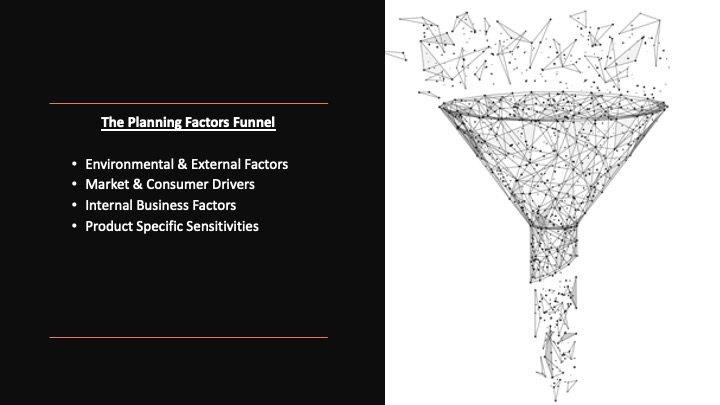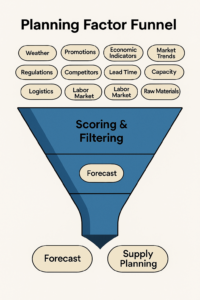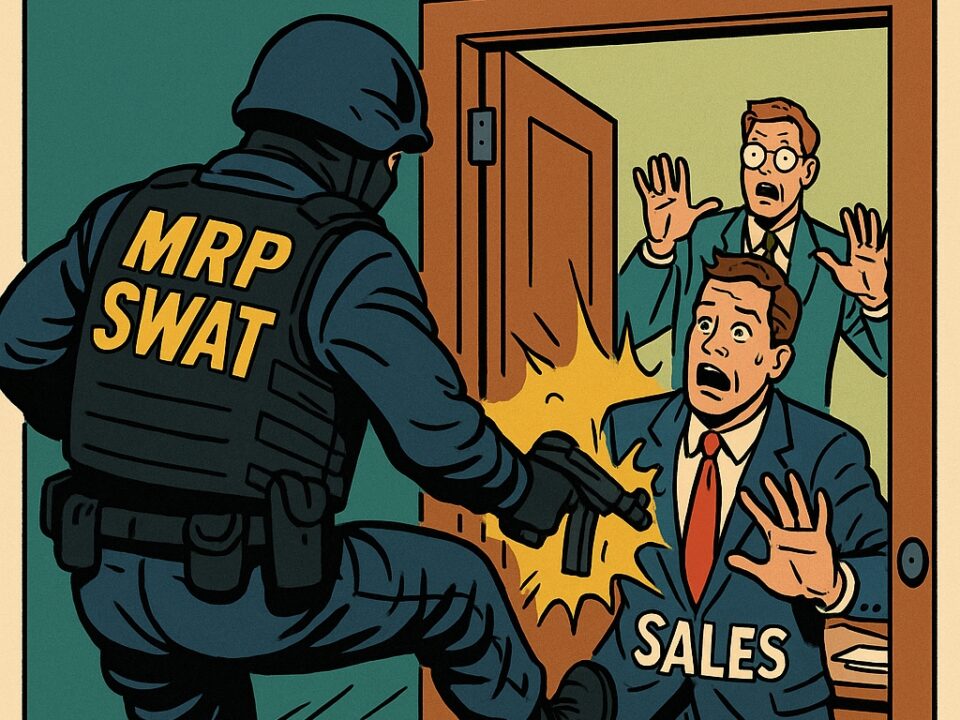
In the intricate world of supply chain planning, accurate forecasting and timely decision-making depends not just on historical data and statistical models, but also on a wide range of dynamic external and internal factors. These may include macroeconomic indicators, weather conditions, promotional activity, geopolitical instability, or even trending consumer behavior.
Yet, while many of these factors can influence outcomes, not all of them are relevant at any given time or for every product. This is where the Planning Factor Funnel comes into play — a practical framework for identifying, filtering, and applying the most impactful variables to forecasting, demand, and supply planning processes.
What Is the Planning Factor Funnel?
The Planning Factor Funnel is a decision-support approach that recognizes the broad universe of potential planning influencers, but channels attention to those most relevant for a specific context, product, geography, or timeframe.
Think of it as a funnel:

- At the top: A wide array of potential factors (macro and micro) are collected.
- In the middle: These areassessed, scored, and filtered through relevance criteria.
- At the bottom: Only the key factors feed into planning models or are flagged for monitoring and action.
Why Is This Important?
Supply chain teams often suffer from two extremes:
- Over-simplification, relying only on sales history and ignoring externalities.
- Over-complication, trying to consider too many factors simultaneously, leading to noise and confusion.
The Planning Factor Funnel provides a structured, yet agile way to reduce complexity while staying responsive to real-world dynamics.
Categories of Planning Factors
To effectively use the funnel, it helps to categorize factors. These may include:
- Environmental & External Conditions
- Weather
- Natural disasters
- Political instability
- Trade regulations
- Transportation disruptions (e.g., port strikes, storms)
- Market & Consumer Drivers
- Seasonality
- Promotions
- Media coverage or social trends
- Product life cycle stage
- Competitor actions
- Internal Business Factors
- Production capacity constraints
- Labor availability
- Inventory levels
- Changes in lead time or cost
- Product-Specific Sensitivities
- Perishability
- Shelf life
- Substitution elasticity
- Demand volatility
Each category can have relevance in different industries and different points in time — so a robust selection mechanism is essential.
How to Select the Most Relevant Factors?
The real value of the Factor Funnel lies in its middle layer — the selection method. Here are a few techniques you could use or combine:
1. Relevance Scoring Matrix
Develop a simple matrix that scores each factor based on:
FACTOR: Heatwave Forecast – SCORE (1-5) – 5 most relevant
PRODUCT RELEVANCE – 5
TEMPORAL RELEVANCE – 4
GEOGRAPHICAL RELEVANCE – 5
IMPACT PROBABILITY – 4
TOTAL SCORE – 18
Set a threshold score (e.g., 15+) above which a factor is actively considered in planning.
2. Scenario Mapping
For products or periods of high uncertainty (e.g., new product launches or extreme seasonality), use scenario-based mapping:
- Create best-case, expected, and worst-case scenarios.
- Assign potential factors to each.
- Use these to simulate impact and select factors accordingly.
3. Machine Learning/Analytics Filters
In mature data environments, ML models can help identify correlations between external factors and historical sales. However, human judgment remains key in ensuring interpretability and timeliness.
4. Stakeholder Workshops
In cross-functional environments, a short, periodic planning factor review involving Sales, Marketing, Operations, and Planning can surface new factors not visible in data alone.
Example questions:
- “What promotions are upcoming that could affect regional demand?”
- “Any supplier updates or logistics concerns?”
- “Are there climate or geopolitical events we should monitor?”
Applying the Funnel in Practice
Once the relevant factors are identified, they can feed into:
- Demand forecasts (adjustments or model inputs)
- Supply constraints (scenario buffers or lead time planning)
- Risk assessments (contingency planning)
- S&OP reviews (fact-based decision-making)
Crucially, the process should be repeatable and lightweight — perhaps reviewed monthly, seasonally, or based on trigger events.
Conclusion
The Planning Factor Funnel is a smart, adaptive framework for making sense of a noisy and complex planning environment. By deliberately scanning widely, filtering methodically, and acting selectively, planners can better anticipate risks and opportunities — improving forecast accuracy, service levels, and overall resilience.
As the next step, developing a standardized selection toolkit — using scoring, triggers, and periodic reviews — will help embed the practice into operational rhythm.




